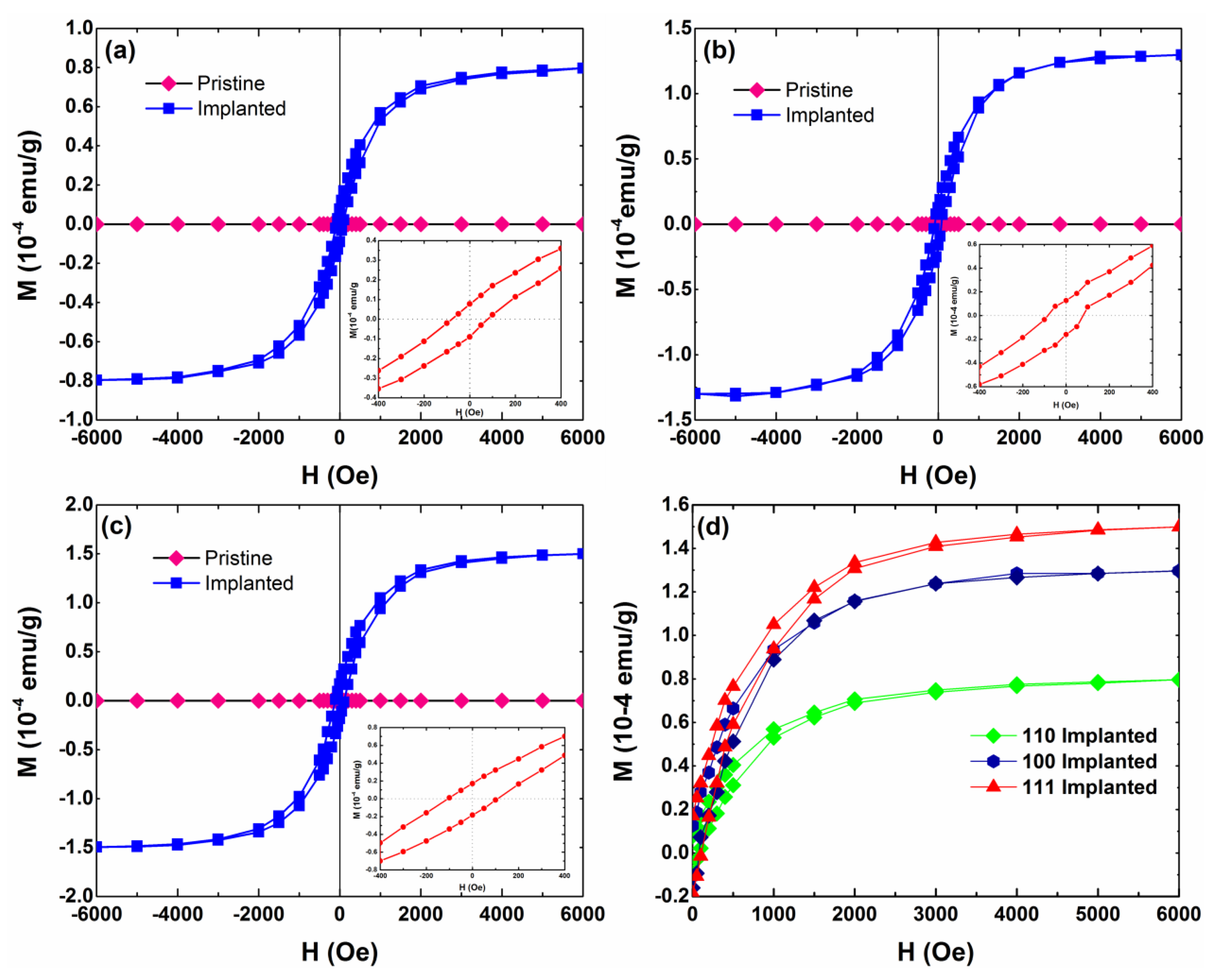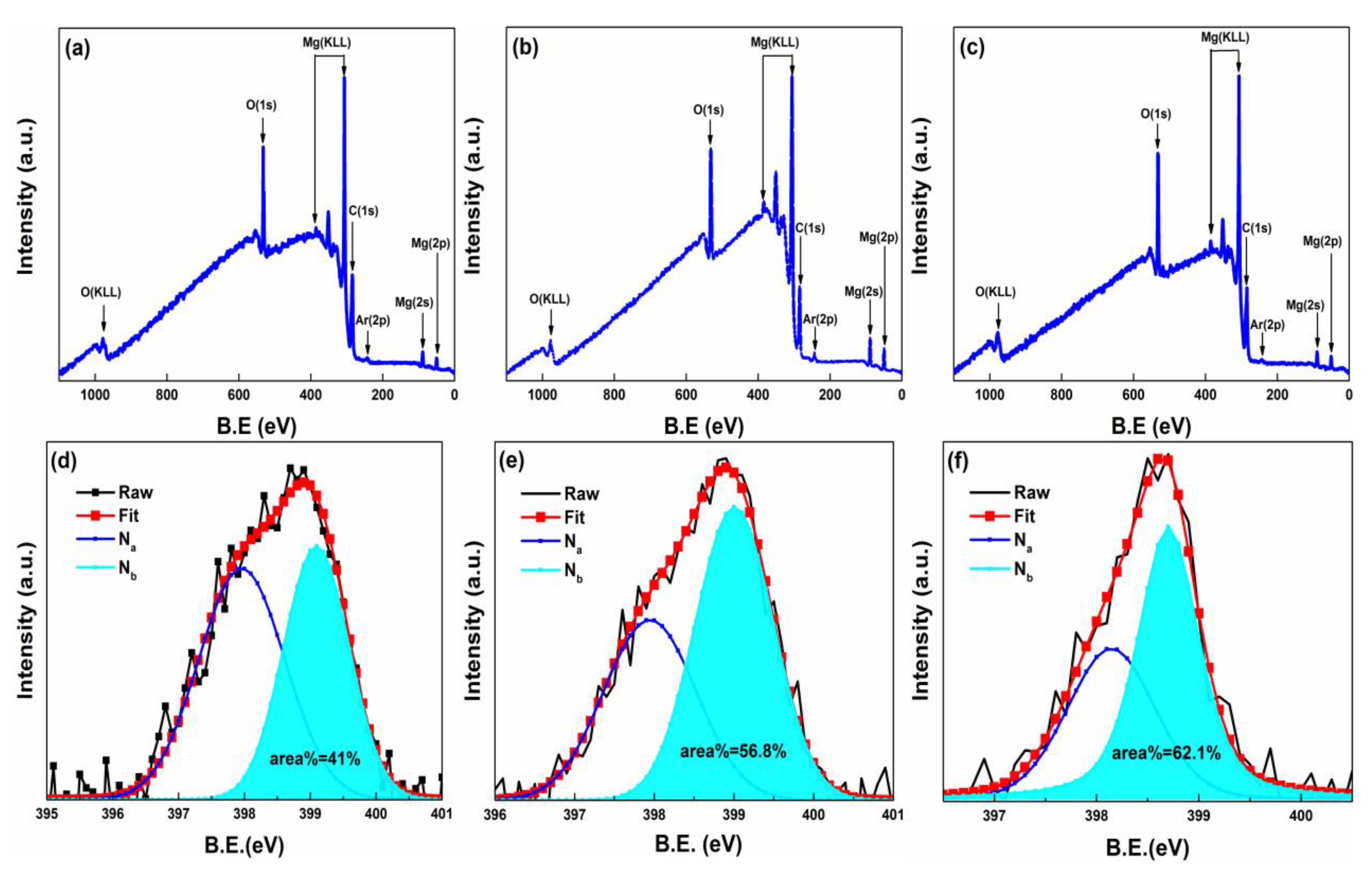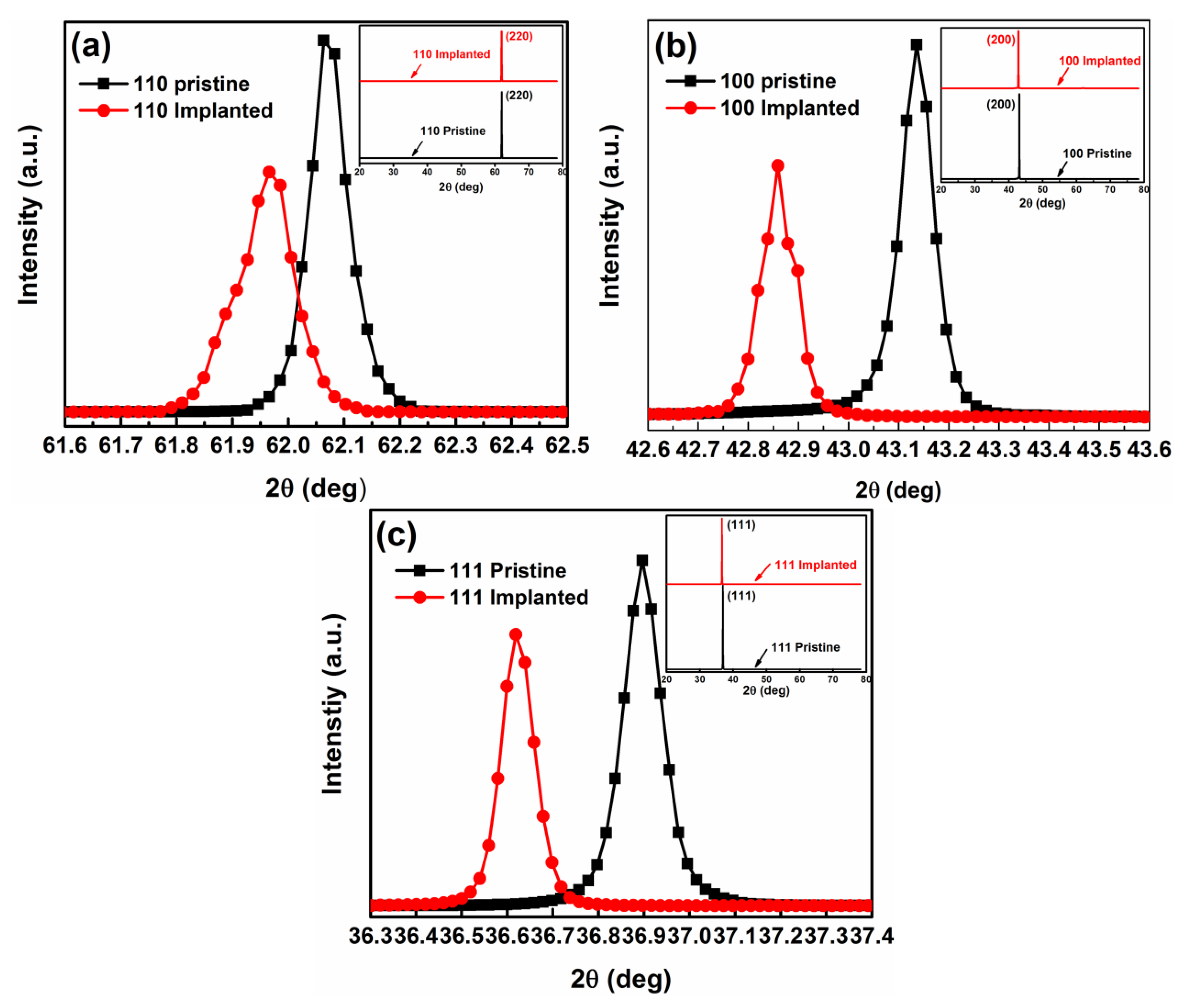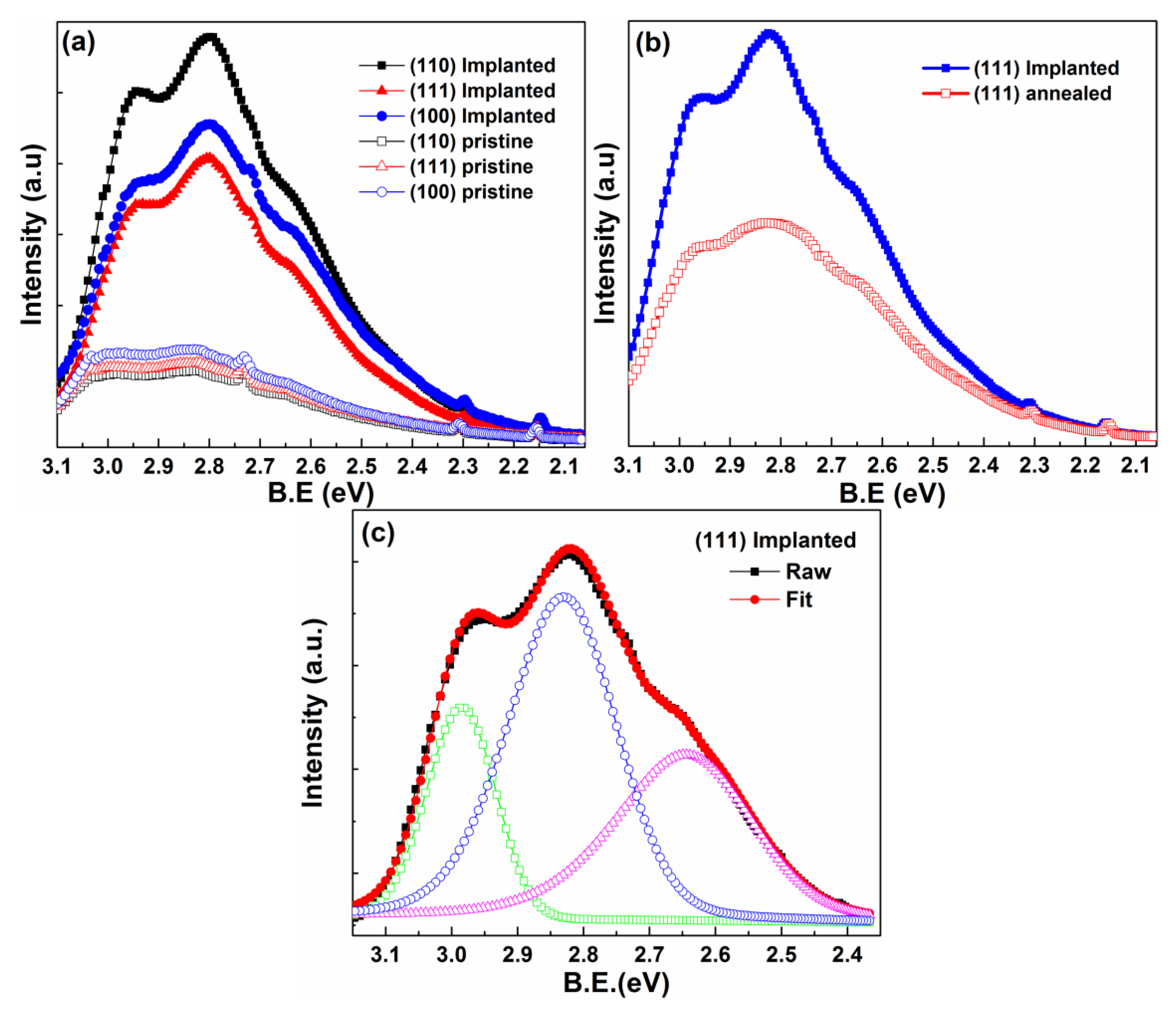Crystalline Orientation-Dependent Ferromagnetism in N+-Implanted MgO Single Crystal
Abstract
1. Introduction
2. Experimental Details
3. Result and Discussion
4. Conclusions
Author Contributions
Funding
Institutional Review Board Statement
Informed Consent Statement
Data Availability Statement
Conflicts of Interest
References
- Yakout, S.M. Spintronics: Future Technology for New Data Storage and Communication Devices. J. Supercond. Nov. Magn. 2020, 33, 2557–2580. [Google Scholar] [CrossRef]
- Zhang, H.; Wang, Y.; Wang, H.; Huo, D.; Tan, W. Room-temperature magnetoresistive and magnetocaloric effect in La1−xBaxMnO3 compounds: Role of Griffiths phase with ferromagnetic metal cluster above Curie temperature. J. Appl. Phys. 2022, 131, 043901. [Google Scholar] [CrossRef]
- Wang, Y.; Ni, S.; Zhang, H.; Wang, H.; Su, K.; Yang, D.; Huang, S.; Huo, D.; Tan, W. The negative magnetization and exchange bias effect in compound NdMnO3: The role of magnetic ordering of Nd3+ and Mn3+ ions. Appl. Phys. A 2022, 128, 839. [Google Scholar] [CrossRef]
- Schmidt, G. Concepts for spin injection into semiconductors—A review. J. Phys. D Appl. Phys. 2005, 38, R107–R122. [Google Scholar] [CrossRef]
- Dey, B.; Narzary, R.; Chouhan, L.; Bhattacharjee, S.; Parida, B.N.; Mondal, A.; Ravi, S.; Srivastava, S.K. Crystal structure, optical and dielectric properties of Ag:ZnO composite-like compounds. J. Mater. Sci. Mater. Electron. 2022, 33, 2855–2868. [Google Scholar] [CrossRef]
- Davis, B.A.; Chakraborty, B.; Kalarikkal, N.; Ramaniah, L.M. Room temperature ferromagnetism in carbon doped MoO3 for spintronic applications: A DFT study. J. Magn. Magn. Mater. 2020, 502, 166503. [Google Scholar] [CrossRef]
- Chakraborty, B.; Nandi, P.K.; Kawazoe, Y.; Ramaniah, L.M. Room-temperature d0 ferromagnetism in carbon-doped Y2O3 for spintronic applications: A density functional theory study. Phys. Rev. B 2018, 97, 184411. [Google Scholar] [CrossRef]
- Wang, X.; Song, Y.; Tao, L.L.; Feng, J.F.; Sui, Y.; Tang, J.; Song, B.; Wang, Y.; Wang, Y.; Zhang, Y.; et al. Origin of ferromagnetism in aluminum-doped TiO2 thin films: Theory and experiments. Appl. Phys. Lett. 2014, 105, 262402. [Google Scholar] [CrossRef]
- Ali, N.; Vijaya, A.R.; Khan, Z.A.; Tarafder, K.; Kumar, A.; Wadhwa, M.K.; Singh, B.; Ghosh, S. Ferromagnetism from non-magnetic ions: Ag-doped ZnO. Sci. Rep. 2019, 9, 20039. [Google Scholar] [CrossRef]
- Akbar, S.; Hasanain, S.K.; Ivashenko, O.; Dutka, M.V.; Ali, N.Z.; Blake, G.R.; De Hosson, J.T.M.; Rudolf, P. Defect ferromagnetism induced by lower valence cation doping: Li-doped SnO2 nanoparticles. RSC Adv. 2020, 10, 26342–26348. [Google Scholar] [CrossRef]
- Araujo, C.M.; Kapilashrami, M.; Jun, X.; Jayakumar, O.D.; Nagar, S.; Wu, Y.; Århammar, C.; Johansson, B.; Belova, L.; Ahuja, R.; et al. Room temperature ferromagnetism in pristine MgO thin films. Appl. Phys. Lett. 2010, 96, 232505. [Google Scholar] [CrossRef]
- Cao, H.; Xing, P.; Zhou, W.; Yao, D.; Wu, P. Indium vacancy induced d ferromagnetism in Li-doped In2O3 nanoparticles. J. Magn. Magn. Mater. 2018, 451, 609–613. [Google Scholar] [CrossRef]
- Li, Q.; Ye, B.; Hao, Y.; Liu, J.; Kong, W.; Ye, B. Annealing temperature effects on the magnetic properties and induced defects in C/N/O implanted MgO. Nucl. Instrum. Methods Phys. Res. Sect. B Beam Interactions Mater. Atoms 2013, 297, 29–34. [Google Scholar] [CrossRef]
- Garg, S.; Gautam, S.; Singh, J.P.; Kandasami, A.; Goyal, N. Characterizing the defects and ferromagnetism in metal oxides: The case of magnesium oxide. Mater. Charact. 2021, 179, 111366. [Google Scholar] [CrossRef]
- Rani, N.; Chahal, S.; Kumar, P.; Kumar, A.; Shukla, R.; Singh, S. MgO nanostructures at different annealing temperatures for d0 ferromagnetism. Vacuum 2020, 179, 109539. [Google Scholar] [CrossRef]
- Wang, X.; Ma, C.; Wang, X.; Zhou, W.; Tan, W. Room temperature ferromagnetism in N-implanted MgO: Synergistic effects of intrinsic and extrinsic defects. Mater. Res. Express 2021, 8, 066102. [Google Scholar] [CrossRef]
- Zambaldi, C.; Zehnder, C.; Raabe, D. Orientation dependent deformation by slip and twinning in magnesium during single crystal indentation. Acta Mater. 2015, 91, 267–288. [Google Scholar] [CrossRef]
- Deng, D.; Peng, R.L.; Brodin, H.; Moverare, J. Microstructure and mechanical properties of Inconel 718 produced by selective laser melting: Sample orientation dependence and effects of post heat treatments. Mater. Sci. Eng. A 2018, 713, 294–306. [Google Scholar] [CrossRef]
- Jespersen, T.S.; Krogstrup, P.; Lunde, A.M.; Tanta, R.; Kanne, T.; Johnson, E.; Nygård, J. Crystal orientation dependence of the spin-orbit coupling in InAs nanowires. Phys. Rev. B 2018, 97, 041303. [Google Scholar] [CrossRef]
- Baubekova, G.; Akilbekov, A.; Feldbach, E.; Grants, R.; Manika, I.; Popov, A.; Schwartz, K.; Vasil’Chenko, E.; Zdorovets, M.; Lushchik, A. Accumulation of radiation defects and modification of micromechanical properties under MgO crystal irradiation with swift 132Xe ions. Nucl. Instrum. Methods Phys. Res. Sect. B Beam Interact. Mater. Atoms. 2019, 463, 50–54. [Google Scholar] [CrossRef]
- Kotomin, E.E.; Kuzovkov, V.; Popov, A.I.; Maier, J.; Vila, R. Anomalous Kinetics of Diffusion-Controlled Defect Annealing in Irradiated Ionic Solids. J. Phys. Chem. A 2017, 122, 28–32. [Google Scholar] [CrossRef] [PubMed]
- Li, Q.; Ye, B.; Hao, Y.; Liu, J.; Zhang, J.; Zhang, L.; Kong, W.; Weng, H.; Ye, B. Room-temperature ferromagnetism observed in C-/N-/O-implanted MgO single crystals. Chem. Phys. Lett. 2013, 556, 237–241. [Google Scholar] [CrossRef]
- Wang, Y.; Liu, C.; Zhang, Y. Progress of d0magnetism in SiC. J. Semicond. 2017, 38, 033006. [Google Scholar] [CrossRef]
- Singh, J.P.; Chae, K.H. d° Ferromagnetism of Magnesium Oxide. Condens. Matter 2017, 2, 36. [Google Scholar] [CrossRef]
- Usov, I.; Arendt, P.; Groves, J.; Stan, L.; DePaula, R. Annealing of radiation damage in (100), (110) and (111) MgO single crystals implanted with Ar+ ions. Nucl. Instrum. Methods Phys. Res. Sect. B Beam Interact. Mater. Atoms. 2006, 243, 87–91. [Google Scholar] [CrossRef]
- Pesci, M.; Gallino, F.; Di Valentin, C.; Pacchioni, G. Nature of Defect States in Nitrogen-Doped MgO. J. Phys. Chem. C 2009, 114, 1350–1356. [Google Scholar] [CrossRef]
- Shinn, N.D.; Tsang, K. Strain-induced surface reactivity: Low temperature Cr/W(110) nitridation. J. Vac. Sci. Technol. A Vacuum Surf. Films 1991, 9, 1558–1562. [Google Scholar] [CrossRef]
- Kanzaki, H. Point defects in face-centred cubic lattice—I distortion around defects. J. Phys. Chem. Solids 1957, 2, 24–36. [Google Scholar] [CrossRef]
- Cao, M.; Ma, Y.; Wang, X.; Ma, C.; Zhou, W.; Wang, X.; Tan, W.; Du, J. Point defects and magnetic properties of neutron irradiated MgO single crystal. AIP Adv. 2017, 7, 056413. [Google Scholar] [CrossRef]
- Trinkaus, H. On Determination of the Double-Force Tensor of Point Defects in Cubic Crystals by Diffuse X-Ray Scattering. Phys. Status Solidi 1972, 51, 307–319. [Google Scholar] [CrossRef]
- Liu, G.; Ji, S.; Yin, L.; Fei, G.T.; Ye, C. An investigation of the electronic properties of MgO doped with group III, IV, and V elements: Trends with varying dopant atomic number. J. Phys. Condens. Matter 2010, 22, 046002. [Google Scholar] [CrossRef] [PubMed]
- Uchino, T.; Okutsu, D. Broadband Laser Emission from Color Centers Inside MgO Microcrystals. Phys. Rev. Lett. 2008, 101, 117401. [Google Scholar] [CrossRef] [PubMed]
- Rosenblatt, G.H.; Rowe, M.W.; Williams, J.G.P.; Williams, R.T.; Chen, Y. Luminescence ofFandF+centers in magnesium oxide. Phys. Rev. B 1989, 39, 10309–10318. [Google Scholar] [CrossRef] [PubMed]
- Kumar, A.; Thota, S.; Varma, S.; Kumar, J. Sol–gel synthesis of highly luminescent magnesium oxide nanocrystallites. J. Lumin. 2011, 131, 640–648. [Google Scholar] [CrossRef]
- Azzaza, S.; El-Hilo, M.; Narayanan, S.; Vijaya, J.J.; Mamouni, N.; Benyoussef, A.; El Kenz, A.; Bououdina, M. Structural, optical and magnetic characterizations of Mn-doped MgO nanoparticles. Mater. Chem. Phys. 2014, 143, 1500–1507. [Google Scholar] [CrossRef]
- Usov, I.; Arendt, P.; Groves, J.; Stan, L.; DePaula, R. Crystallographic orientation dependence of radiation damage in Ar+ implanted YSZ and MgO single crystals. Nucl. Instrum. Methods Phys. Res. Sect. B Beam Interact. Mater. Atoms. 2005, 240, 661–665. [Google Scholar] [CrossRef]
- Moll, S.; Zhang, Y.; Debelle, A.; Thomé, L.; Crocombette, J.; Zihua, Z.; Jagielski, J.; Weber, W. Damage processes in MgO irradiated with medium-energy heavy ions. Acta Mater. 2015, 88, 314–322. [Google Scholar] [CrossRef]
- Mao, Z.; He, Z.; Chen, D.; Cheung, W.; Wong, S. Crystal orientation dependence of ferromagnetism in Fe-implanted MgO single crystals. Solid State Commun. 2007, 142, 329–332. [Google Scholar] [CrossRef]





Publisher’s Note: MDPI stays neutral with regard to jurisdictional claims in published maps and institutional affiliations. |
© 2022 by the authors. Licensee MDPI, Basel, Switzerland. This article is an open access article distributed under the terms and conditions of the Creative Commons Attribution (CC BY) license (https://creativecommons.org/licenses/by/4.0/).
Share and Cite
Wang, X.; Ma, C.; Zhou, W.; Tan, W. Crystalline Orientation-Dependent Ferromagnetism in N+-Implanted MgO Single Crystal. Materials 2022, 15, 7274. https://doi.org/10.3390/ma15207274
Wang X, Ma C, Zhou W, Tan W. Crystalline Orientation-Dependent Ferromagnetism in N+-Implanted MgO Single Crystal. Materials. 2022; 15(20):7274. https://doi.org/10.3390/ma15207274
Chicago/Turabian StyleWang, Xingyu, Chunlin Ma, Weiping Zhou, and Weishi Tan. 2022. "Crystalline Orientation-Dependent Ferromagnetism in N+-Implanted MgO Single Crystal" Materials 15, no. 20: 7274. https://doi.org/10.3390/ma15207274
APA StyleWang, X., Ma, C., Zhou, W., & Tan, W. (2022). Crystalline Orientation-Dependent Ferromagnetism in N+-Implanted MgO Single Crystal. Materials, 15(20), 7274. https://doi.org/10.3390/ma15207274




